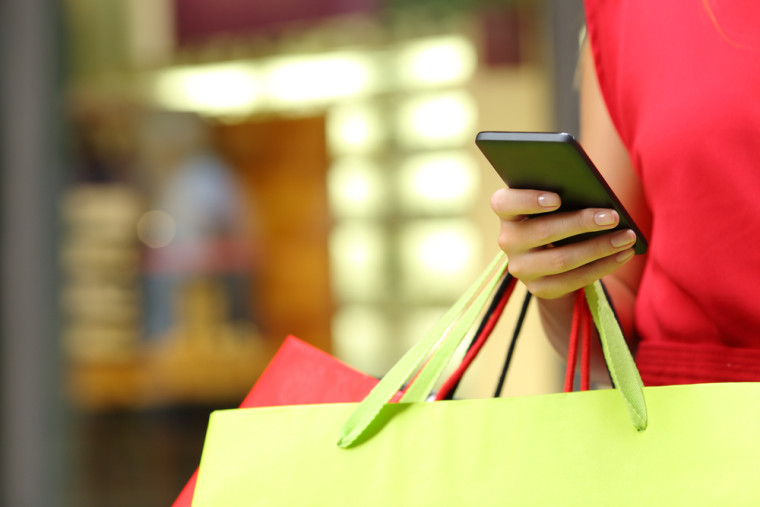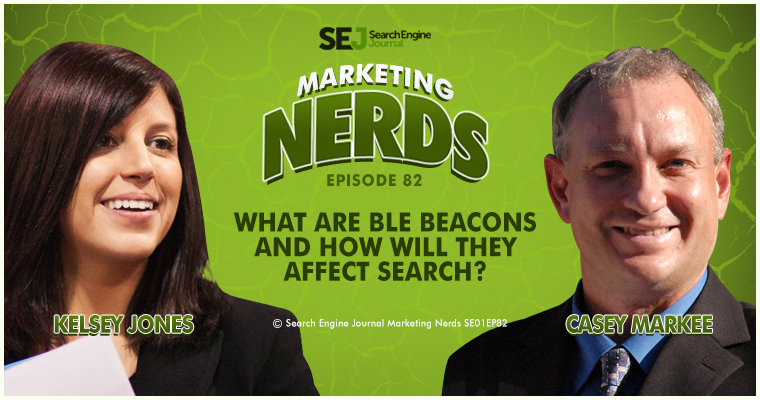Podcast: Download
Subscribe: Apple Podcast Google Podcasts Spotify
Visit our Marketing Nerds archive to listen to other Marketing Nerds podcasts!
In this week’s episode of Marketing Nerds, Casey Markee of MediaWyse and Search Engine News joins SEJ Executive Editor Kelsey Jones to discuss what beacons are how they are already being used, and how to start implementing them in your own search and discovery campaigns to reach more customers.
Want to hear more from Kelsey and Casey? In a previous episode, they talked about wearables, Google’s Knowledge Graph, the growing popularity of Apple Watch, and what it means to search.

Here are a few transcribed excerpts from their discussion, but make sure to listen to the podcast to hear everything:
What are BLE Beacons and How Do They Apply to SEO
BLE stands for Bluetooth Low Energy. Beacons themselves are kind of these low-cost transmitters that use this Bluetooth Low Energy, BLE, to provide Bluetooth smart devices kind of a new level of proximity awareness.
You’ve likely heard of Yext if you’re an SEO, especially a local SEO. Yext has come out with a really cool product called Xone, which is a beacon-powered marketing custom ability that involves the use of beacons you can set up at a location. Customers opt in, either through an app network or by downloading a specific app themselves. You can collect information from those customers based upon matching their personas to readily available information on Facebook and Twitter, or you can just use it for customized messaging.
Whether or not you have an offer you want to serve for people who are specifically in a location, or maybe you want to use it as a customer contact point or other areas. There are really a plethora of ways to use the info.
When we talk about beacons, we’re going to be talking today kind of about what are the different wireframes, what are some of the novel uses of beacons, and why they’re really getting so big right now.
Example of When a Beacon Would be Useful
One of the examples is in Portland, they have a transit entity there.
They were one of the first to actually use what are called Eddystone beacons, and Eddystone is kind of the Google beacon support functionality there. With Eddystone, Google went out, saw what everyone else was doing, and realized, “There are some things that we can improve upon,” and so then they launched this Eddystone beacon around June of 2015, and one of the examples again is with this TriMet, which is the transit authority in Portland.
Basically if you are standing on any of their platforms, you will actually trigger one of these really cool beacon messages.
The beacons will allow to you access things like train schedules. They have about 87 different light rail stations, and they use the beacons to beam notifications to commuters, just letting them know where they are when the train is approaching.
That’s the whole point of the beacons, is to provide just-in-time messaging for someone who’s ablt to use that information at the appropriate time.
How Beacons Push Notifications to Users
There’s two ways to do that, especially with the TriMet case. Initially, when they set it up, they were able to use the alert screen, the notification screen, within Android. If you got close, you could let them know that you were near this TriMet station. You opt in. Basically most people opt in any way because they have Bluetooth turned on on their phones.
When that happened, when they were close, the beacons would connect with the cellphones and they would send an alert screen that would pop up notifications to those who were in range, letting them know, “Hey, are you at one of these 87 light rail stations? Well, if you are, here is the schedule for the next train that’s coming.”
Beacons in E-Commerce and Retail Stores
You’re going to see a lot of the bigger retailers are already doing this.
Nordstrom is actually starting to implement their campaign, and one of the most effective was the Apple Watch when it was launched last year. Even though it wasn’t the slam dunk everyone hoped it would be, one of the things they were able to do was use beacons initially to kind of push the many benefits that come with having something directly on your wrist that you have access to all the time.
There’s a couple different frameworks, and I guess we should briefly go over that. You have iBeacon. iBeacon is Apple. iBeacon has kind of the initial beacon functionality. It’s very proprietary. It must have an app to work, so basically you have an app, you have these beacons.
The beacons are really like lighthouses. They send out a signal. That’s all they do. When you have the app, though, is really when the magic happens. The app will read the beacon, and then you can use this beacon messaging to do various things.
In the case of iBeacon, one of the things they were able to do specifically with the Apple Watch is there’s a very cool chain of shopping retailers in the Midwest. It’s called Marsh Supermarkets. They’re based in Indiana, and they were the first grocery store chain. There’s about 75 stores there, and they launched this iBeacon Apple Watch integration, and basically just allowed for shoppers with an Apple Watch and the app on their phone to be notified of their shopping list when they entered any Marsh store.
There are beacons in all of the stores, and the beacons would just navigate you throughout the store and let you know where everything on your shopping list was. It’s just a very simplistic way of using beacons, and you’ll see beacons being used all the time if you go to a museum. If you can download their app, you can push enable and you’ll be able to have a virtual map that will lead you around the place.
Or there’s even harvesting capabilities for it. There are companies in Germany now that are using apps based off of their trucks, so they’re able to let everyone know when they’ve picked up a load of grain and left, and then they’re able to measure what the weight of the truck is, where it left. It’s very similar to GPS, only it’s done by beacon.
Eddystone for Android Phones
Google went, studied the iBeacon technology and realized, “You know, we can make this work without having to use apps.” Now, we’re still going to use the apps because you can do just a ton with the app functionality, but Eddystone has really kind of put in some different wireframes, and one of the wireframes that they’ve put in is the ability to use a URL. You can actually just throw up a URL to someone. They’ll see it with Eddystone. It’ll show up on your phone, and you could click-through and direct the customer anywhere you’d like.
It just depends on what your focus is, and there are lots of different things to do. The good thing about Eddystone is that because Google now is so predominant, it can provide a little bit more increased contextual information, like showing menu items when people sit down at a restaurant, which is really cool.
You’re going to see more and more of this. For example, when you check in for an airline, you have the option to throw a beacon into your luggage and be able to track your luggage, from your starting point to your destination, so you’d never have to worry about losing your luggage.
Enabling Beacon for Various Businesses
Basically you must have the beacon, and there are tons of different beacons you can buy. The various companies out there, there are Blue Sense, Estimotes, Kontakt, Gimbal. You can buy any of these beacons and then you just set up your own beacon wireframe.
Most of them, when you buy a beacon from a specific manufacturer or provider, they will come with your own ability to set up your beacon program. You can do a custom app, or in the case of Eddystone, you could just do some custom coding so that it’ll throw out URLs at specific periods or at specific places, depending upon the devices that are connecting around you.
One of the easiest ways to get going with beacons is to search for a company called Beaconstac. They have this really cool Starter Kit, and each of the beacons cover between, you know, 50 to 100 feet with beacons, and this is an important point.
The wider you try to broadcast the beacons, the less the battery life, so most beacons out of the box will last a couple of years. Basically the longer you want to cover, the distance, usually up to 200 feet or so, the less the battery life is. You could conceivably have a beacon that might only last three or four months. Usually you want to try to do smaller areas, 50 feet. Usually if you’ve got a set of three beacons, you can cover most retail establishments no problem, through the overlapping zones.
The Beaconstac kit is really cool because it’s so WYSIWYG. You just get the beacon, you download your app, you play around. You add some graphics, you do a little very quick wireframe and then, boom, you’re done. If you want to run your own beacon campaign, that’s one of the fastest and easiest ways to get going.
If you’re like me and you’re just not very tech-savvy or you really don’t want to set up a ton of your own campaigns, you can actually use a lot of existing networks, for example, and there’s a really cool provider called Mobiquity. And all they do is they have access to existing beacon networks. For example, at shopping malls.
Let’s say you have a product you’re starting to prepare for the holiday shopping season, and you want to get the widest reach possible. What you could do is you could look up Mobiquity, and then kind of negotiate a campaign with them to use some of the existing 50,000 storefront beacons they already have enabled in malls all around the United States.
What Lies Ahead for BLE Beacons in 2016 and Beyond
I really do think that 2016 is just going to be a huge year.
I read a stat the other day about how there was like 95 percent of the top 100 mall retailers were going to have beacons enabled by the end of 2016. It’s insane.
How Businesses Could Get Started
I think a bigger company, someone who has multiple locations, is going to be better served by doing something on their own, whether it’s Eddystone or iBeacon. If you’re just starting out, you’re probably, in my opinion, going to be focused on Eddystone capability because, with that huge upgrade to Android and Chrome.
Android by far is still the most popular phone in the world. You’re going to have such access to that large number of people. That is really the basis of where you’d want to start, is with something that’s Android-capable, something that uses that discovery app and lets you use existing networks as well, which is pretty cool.
Beacons are widespread. They’re not going anywhere. You’re going to see a ton more of them by the end of 2016. More than that, beacons enhance marketing. If you’re looking for just another layer to drive traffic or retarget to your existing customers, or just use them to enhance offers and current experiences, beacons are the way to go.
To listen to this Marketing Nerds podcast with Kelsey Jones & Casey Markee:
- Listen to the full episode at the top of this post
- Subscribe via iTunes
- Sign up on IFTTT to receive an email whenever the Marketing Nerds podcast RSS feed has a new episode
- Listen on Stitcher
Think you have what it takes to be a Marketing Nerd? If so, message Kelsey Jones on Twitter, or email her at kelsey [at] searchenginejournal.com.
Visit our Marketing Nerds archive to listen to other Marketing Nerds podcasts!
![]() Image Credits
Image Credits
Featured Image: Image by Paulo Bobita
In-post Photo: Antonio Guillem/Shutterstock.com




